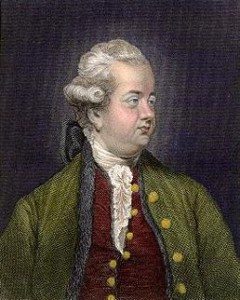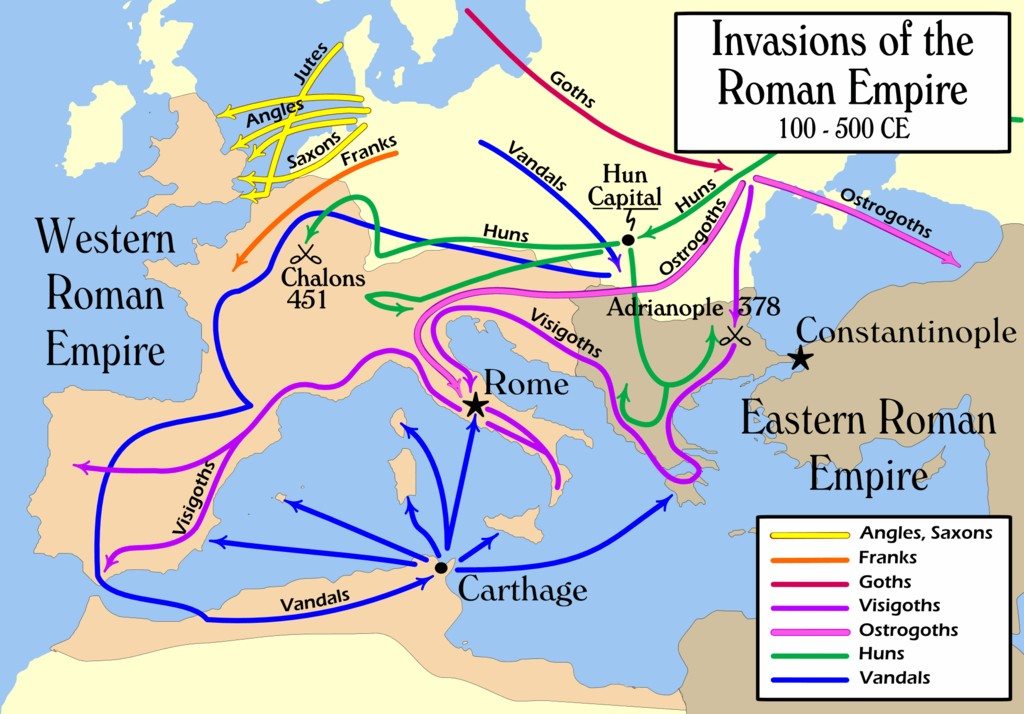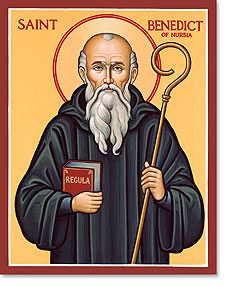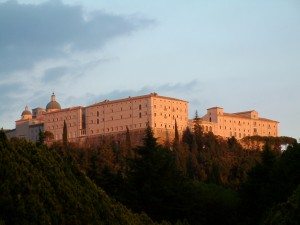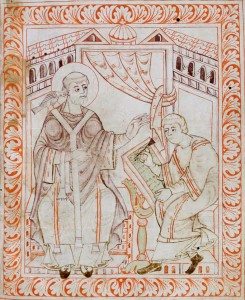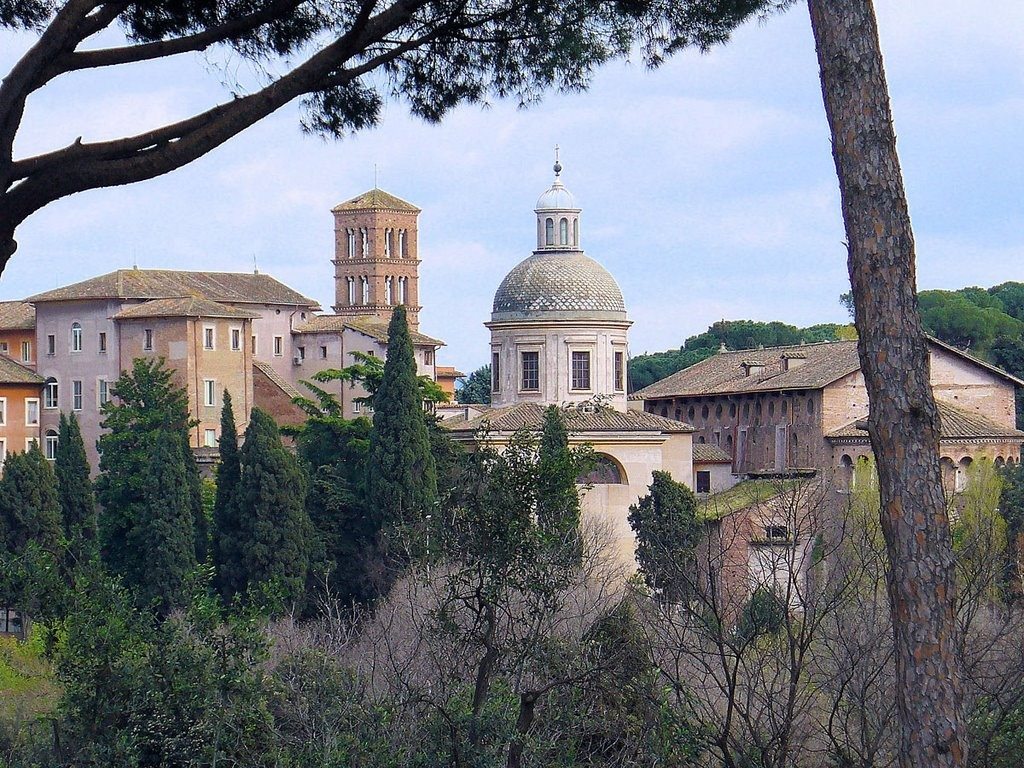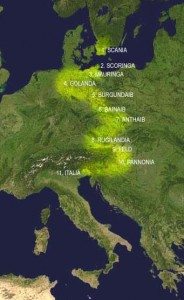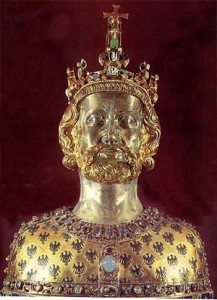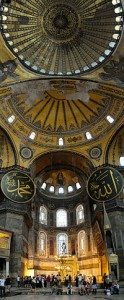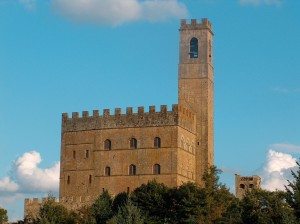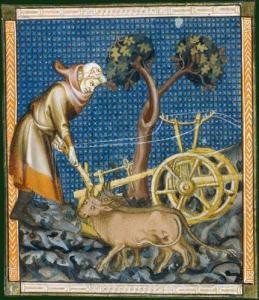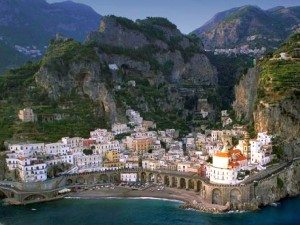Week 1
Week 1: Tuesday, October 6, 2015
The Decline and Fall of the Roman Empire
In our first week of study during the History of Medieval Italy, we will look back at the fall of the Roman Empire and examine the many theories about the causes.
"The Fall of the Western Roman Empire was the period of decline in the Western Roman Empire in which it disintegrated and split into numerous successor states. By 476 AD when Odoacer deposed the Emperor Romulus, the Western Roman Empire wielded negligible military, political, or financial power and had no effective control over the scattered Western domains that could still be described as Roman. Invading "barbarians" had established their own polities on most of the area of the Western Empire. While its legitimacy lasted for centuries longer and its cultural influence remains today, the Western Empire never had the strength to rise again." from Wikipedia. Photo above: Edward Gibbon by Henry Walton.
RECOMMENDED READING
The Decline and Fall of the Roman Empire by Edward Gibbon published in 1776-1789
"The History of the Decline and Fall of the Roman Empire (sometimes shortened to Decline and Fall of the Roman Empire) is a book of history written by the English historian Edward Gibbon, which traces the trajectory of Western civilization (as well as the Islamic and Mongolian conquests) from the height of the Roman Empire to the fall of Byzantium. It was published in six volumes. Volume I was published in 1776 and went through six printings. Volumes II and III were published in 1781; volumes IV, V, and VI in 1788–89. The original volumes were published in quarto sections, a common publishing practice of the time. The work covers the history of the Roman Empire, Europe, and the Catholic Church from 98 to 1590 and discusses the decline of the Roman Empire in the East and West. Because of its relative objectivity and heavy use of primary sources, unusual at the time, its methodology became a model for later historians. This led to Gibbon being called the first "modern historian of ancient Rome". (from Wikipedia)
2
Week 2: Tuesday, October 13, 2015
Benedict: Origins of Western Monasticism
In the seventy-plus years between the last Roman Emperor (476 AD) and the death of Benedict (547 AD), Western Europe created a whole new version of Christianity: monastic Christianity. Born in the years of massive social unrest and political collapse, the new monastic life as it came to be lived in Italy under the leadership of Benedict, appealed to both men and women, rich and poor, young and old. It offered people the opportunity to withdraw from the confusion and to move into a safe space and to join a community of like-minded individuals who welcomed the simplicity of monastic life. The single most important individual in the creation of this new way of life was Benedict of Nursia.
Here is a summary of Benedict from Wikipedia:
Benedict of Nursia (Italian: San Benedetto da Norcia) (480 to 547) is a Christian saint, honoured by the Catholic Church and the Anglican Church[1] as the patron saint of Europe and students. Benedict founded twelve communities for monks at Subiaco, Italy (about 40 miles (64 km) to the east of Rome), before moving to Monte Cassino in the mountains of southern Italy. The Catholic Order of St Benedict and the Anglican Order of St Benedict are of later origin and, moreover, not an "order" as commonly understood but merely a confederation of autonomous congregations. Benedict's main achievement is his "Rule of Saint Benedict", containing precepts for his monks. It is heavily influenced by the writings of John Cassian, and shows strong affinity with the Rule of the Master. But it also has a unique spirit of balance, moderation and reasonableness, and this persuaded most religious communities founded throughout the Middle Ages to adopt it. As a result, his Rule became one of the most influential religious rules in Western Christendom. For this reason, Benedict is often called the founder of western monasticism.
REQUIRED READING:
This is one of the most influential books ever written. For over one thousand years, millions of people looked to this simple guide for a rule as to how to live each day, each week, each month. And here we have it in this nice little inexpensive paperback edition.
PART TWO: MONTE CASSINO
Monte Cassino is a rocky hill about 130 kilometres (81 mi) southeast of Rome, Italy, 2 kilometres (1.2 mi) to the west of the town of Cassino (the Roman Casinum having been on the hill) and 520 m (1,706.04 ft) altitude. St. Benedict of Nursia established his first monastery, the source of the Benedictine Order, here around 529. It was the site of the Battle of Monte Cassino in 1944, where the building was destroyed by Allied bombing and rebuilt after the war. The site has been visited many times by the Popes and other senior clergy, including Pope Benedict XVI in May 2009.
(from Wikipedia, photo below:Monte Cassino Opactwo 1CC BY-SA 3.0)
3
Week 3: Tuesday, October 20, 2015
Gregory the Great: the Last Roman
Pope Gregory I (540 to 604), commonly known as Saint Gregory the Great, was Pope from September 590 to his death in 604. Gregory is well known for his writings, which were more prolific than those of any of his predecessors as pope. He is also known as St. Gregory the Dialogist in Eastern Orthodoxy because of his Dialogues. For this reason, English translations of Orthodox texts will sometimes list him as "Gregory Dialogus". Throughout the Middle Ages he was known as “the Father of Christian Worship” because of his exceptional efforts in revising the Roman worship of his day ] His contributions to the development of the Divine Liturgy, still in use in the Eastern Orthodox Church, were so significant that he is generally recognized as its de facto author. He was the first of the popes to come from a monastic background. Gregory is a Doctor of the Church and one of the Latin Fathers. He is considered a saint in the Roman Catholic Church, Eastern Orthodox Church, Anglican Communion, and some Lutheran churches. Immediately after his death, Gregory was canonized by popular acclaim. The Protestant reformer John Calvin admired Gregory and declared in his Institutes that Gregory was the last good pope. He is the patron saint of musicians, singers, students, and teachers. (from Wikipedia) Photo above: Saint Gregory Dictating the Gregorian Chants, from the Antiphony of Hartker of the monastery of Saint Gall.
PART TWO: Pictures
The Caelian Hill in Rome, Gregory's home and monastery
RECOMMENDED READING:

Gregory,
The Dialogues of Saint Gregory the Great,
by Edmund G. Gardner,
Christian Roman Empire Series, 2010,
ISBN 1889758949
4
Week 4: Tuesday, October 27, 2015
Challenge from Across the Sea
In the year 570 AD in the city of Mecca was born a religious leader who would change the world: Muhammed (570 to 632). Muhammed led a new religious empire that spread all across the Middle East during the seventh century AD. This new force exploded across the Mediterranean and challenged the new Christian Italy. Islamic navies sailed up the rivers of Italy and attacked hundreds of Italian communities including Rome itself (800's). As a result of these new Islamic invasions, the seventh and eighth centuries became one of the most violent and destructive periods in all of Italian history. Some historians consider that it was this period from 650 AD on that witnesses the real end of Classical Rome and ushers in the Dark Ages.
"Muhammed unified Arabia into a single religious polity under Islam. Believed by Muslims to be a messenger and prophet of God, Muhammad is considered by Muslims as the last prophet sent by God to mankind. While non-Muslims regard Muhammad as the founder of Islam, Muslims consider him to have restored the unaltered original monotheistic faith of Adam, Noah, Abraham, Moses, Jesus, and other prophets" (Wikipedia)
Islam is the monotheistic religion articulated by the Qur’an, a text considered by its adherents to be the verbatim word of God, and by the teachings and normative example (called the Sunnah and composed of Hadith) of Muhammad, considered by them to be the last prophet of God. An adherent of Islam is called a Muslim. Muslims believe that God is one and incomparable and the purpose of existence is to worship God. Muslims also believe that Islam is the complete and universal version of a primordial faith that was revealed at many times and places before, including through Abraham, Moses and Jesus, whom they consider prophets. They maintain that previous messages and revelations have been partially changed or corrupted over time, but consider the Qur'an to be both the unaltered and the final revelation of God. Religious concepts and practices include the five pillars of Islam, which are basic concepts and obligatory acts of worship, and following Islamic law, which touches on virtually every aspect of life and society, providing guidance on multifarious topics from banking and welfare, to warfare and the environment. The majority of Muslims are Sunni, being over 75-90% of all Muslims. The second largest sect, Shia, makes up 10-20%. About 13% of Muslims live in Indonesia, the largest Muslim country, 25% in South Asia, 20% in the Middle East, 2% in Central Asia, 4% in the remaining South East Asian countries, and 15% in Sub-saharan Africa. Sizable communities are also found in China and Russia, and parts of Europe. With over 1.5 billion followers or over 22% of earth's population as of 2009, Islam is the second-largest and one of the fastest-growing religions in the world. (from Wikipedia)
RECOMMENDED READING
This is the best one-volume introduction to Islam.

Bernard Ellis Lewis,
Islam: The Religion and the People,
Pearson Prentice Hall; 1 edition (August 29, 2008),
ISBN 0132230852
Praise for Bernard Lewis:
"For newcomers to the subject, Bernard Lewis is the man." TIME Magazine
“The doyen of Middle Eastern studies." The New York Times
“No one writes about Muslim history with greater authority, or intelligence, or literary charm.” British historian Hugh Trevor-Roper.
5
Week 5: Tuesday, November 3, 2015
Italy and the Lombards
The Lombards were a Germanic tribe who ruled Italy from 568 to 774. The Lombard historian Paul the Deacon wrote in the Historia Langobardorum that the Lombards descended from a small tribe called the Winnili who dwelt in southern Scandinavia before migrating to seek new lands. In the 1st century AD they formed part of the Suebi, in northwestern Germany. By the end of the 5th century they had moved into the area roughly coinciding with modern Austria north of the Danube river, where they subdued the Heruls and later fought frequent wars with the Gepids. The Lombard king Audoin defeated the Gepid leader Thurisind in 551 or 552; his successor Alboin eventually destroyed the Gepids at the Battle of Asfeld in 567. Following this victory, Alboin decided to lead his people to Italy, which had become severely depopulated after the long Gothic War (535–554) between the Byzantine Empire and the Ostrogothic Kingdom there. The Lombards were joined by numerous Saxons, Heruls, Gepids, Bulgars, Thuringians, and Ostrogoths, and their invasion of Italy was almost unopposed. By late 569 they had conquered all the principal cities north of the Po River except Pavia, which fell in 572. At the same time, they occupied areas in central and southern Italy. They established a Lombard Kingdom in Italy, later named Regnum Italicum ("Kingdom of Italy"), which reached its zenith under the 8th-century ruler Liutprand. In 774, the Kingdom was conquered by the Frankish King Charlemagne and integrated into his Empire. However, Lombard nobles continued to rule parts of the Italian peninsula well into the 11th century when they were conquered by the Normans and added to their County of Sicily. Their legacy is apparent in the regional name, Lombardy. (From Wikipedia)
RECOMMENDED READING
This two-volume history of Florence is the best detailed study of Florence ever written. Schevill wrote a masterpiece of well researched narrative history for Florence in 1936 and then it was republished in a Harper Torchbook paperback in 1961. The Harper Torchbook is still out there in used book stores so we have purchased five for our library. But there are still copies left if you want to own one. It is two volumes with the first volume devoted to our period of Medieval History and the second volume on Renaissance Florence. For the Lombards see Medieval Florence (Volume 1) Chapter Three, "Darkness Over Florence."

Ferdinand Schevill,
Medieval and Renaissance Florence,
Harper Torchbook paperback, 1963, 2 volumes,
ISBN B000PX4SUU
6
Week 6: Tuesday, November 10, 2015
Italy and the Carolingians
In the aftermath of the collapse of the Roman Empire, many new political entities arose within the former imperial domain: Lombardian Italy, Visigothic Spain, and Anlo-Saxon kingdoms. The one most successful regime was that which was built by the Franks in northern France. The heart of the Frankish kingdom was the Loire valley and the city of Tours. Over a period of 300 years, the Frankish state expanded to include all of northern France, Belgium, south to the Pyrenees and north east into the Rhineland. And in the 700's the dynasty of the Carolingians emerged to dominate the Frankish state with Pepin the Short being crowned as King of the Franks in 751. The name of the Carolingians came from the founding father of the dynasty Charles Martel (Carolus, 688-741). Charles Martel's son and successor was Pepin the Short, and Pepin's son and successor was Charles the Big, or Charlemagne (742-814). At the time of the coronation of Pepin, the situation of the church in Italy had become desperate. Abandoned by the Eastern church in Constantinople, Rome was now at the mercy of the expanding Lombard state which controlled all of northern Italy. In 751, the Lombards took Ravenna which signaled the increasing isolation of the Roman church. In 754, Pope Stephen II searched for an ally to help him in the coming battle with the Lombards. The strongest state in Europe at the time was the Frankish state now ruled by Pepin the Short. In January, 754 Pope Stephen traveled to Paris to meet with Pepin and at the conclusion of their conference the two men made a deal that would drive the next 1000 years of European history: the Pope would crown Pepin as king and thus solidify his new position with the imprimatur of the Vatican, and in exchange Pepin would come to Italy with troops to take on the Lombards. Notice that at this point, no one is using the word, "Emperor." That will wait for Christmas, 800. Various events intervened to push the most important confrontation forward for many years and it fell to Pepin's son Charles (Charlemagne) to lead and win the assault on the Lombards and to receive the thanks of the Papacy on December 25, 800 in Rome. On that date Charlemagne was crowned with the new title: "Holy Roman Emperor." And with this coronation was begun the 1000 year history of the Holy Roman Empire, about which Voltaire quipped: "It was neither Roman, nor Holy, nor an Empire."
REQUIRED READING:

Einhard,
The Life of Charlemagne,
Ann Arbor Paperbacks,
ISBN 047206035X
ABOUT THIS BOOK:
Vita Karoli Magni (Life of Charles the Great) is a biography of Charlemagne, King of the Franks and Holy Roman Emperor, written by Einhard. Historians have traditionally described the work as the first example of a biography of a European king. The author endeavored to imitate the style of that of the ancient Roman biographer Suetonius, most famous for his work the Twelve Caesars. Einhard's biography is especially modeled after the biography of Emperor Augustus, the first emperor of the Roman Empire. The date of the work is uncertain and a number of theories have been put forward. The inclusion of Charlemagne's will at the end of the work makes it fairly clear that it was written after his death in 814. The first reference to the work, however, comes in a letter to Einhard from Lupus of Ferrieres which is dated to the mid-ninth century. Dates have been suggested ranging from about 817 to 833, usually based on interpretations of the text in the political context of the first years of the reign of Louis the Pious and Louis' attitude to his father. Einhard's book is about intimate glimpses of Charlemagne's personal habits and tastes. He occupied favoured position at Charlemagne's court so he had inside information. Einhard received advanced schooling at the monastery of Fulda sometime after 779. Here he was an exceptional student and was quite knowledgeable. The word was sent to Charlemagne of Einhard's expertise. He was then sent to Charlemagne’s Palace School at Aachen in 791. Einhard then received employment at Charlemagne's Frankish court about 796. He remained at this position for twenty some years. Einhard's book was expressly intended to convey his appreciation for advanced education. He wrote his biography after he had left Aachen and was living in Seligenstadt. Einhard's position while with Charlemagne was that of a modern day minister of public works, so he had intimate knowledge of his court. Einhard was also given the responsibility of many of Charlemagne's abbeys.
RECOMMENDED READING:
REVIEWS:
From Publishers Weekly Christian warrior, scholar prince, pilgrim saint and emperor, Charlemagne (742–814) has influenced modern rulers from Napoleon to Charles de Gaulle. As acclaimed British historian Wilson (Tudor Tapestry: Men, Women, and Society in Reformation England) points out in this fast-paced biography, the Frankish king who was named emperor by the pope brought civilization and peace to Europe in the Early Middle Ages. An acquisitive king intent on expanding Francia's borders and connecting politics and religion, Charles the Great, according to Wilson, is responsible for the shape of Europe as we know it today. Wilson deftly chronicles Charlemagne's military exploits, political intrigues and religious devotion. In addition to his military leadership, the emperor initiated a revival of humane learning (the Carolingian Renaissance) and the establishment of a clerical hierarchy that could preach, administer the sacraments properly and oversee matters of the empire. Although, as Wilson points out, Charlemagne's sometimes megalomaniacal personality drove his armies to the brink of disaster, he fostered a unity and a culture in his empire that have lasted to modern times. Maps. Copyright © Reed Business Information, a division of Reed Elsevier Inc.
This two-volume history of Florence is the best detailed study of Florence ever written. Schevill wrote a masterpiece of well researched narrative history for Florence in 1936 and then it was republished in a Harper Torchbook paperback in 1961. The Harper Torchbook is still out there in used book stores so we have purchased five for our library. But there are still copies left if you want to own one. It is two volumes with the first volume devoted to our period of Medieval History and the second volume on Renaissance Florence. For the Lombards see Medieval Florence (Volume 1) Chapter Three, "Darkness Over Florence."

Ferdinand Schevill,
Medieval and Renaissance Florence,
Harper Torchbook paperback, 1963, 2 volumes,
ISBN B000PX4SUU
7
Week 7: Tuesday, November 17, 2015
Rome in the East
By the 300's AD, the leadership of the Roman Empire was divided among several locations: Rome, Milan, and in the east a new city that would become the favorite residence for the new leader Constantine. During his lifetime and that of his direct descendants, this new city on the Bosporus straits, Constantinople, became more and more the real capital of the Roman Empire. The eastern provinces were rich and often more peaceful than the European provinces within which order was breaking down. By the 500's the Emperors ruled from Constantinople and their Italain viceroys reported to the Eastern capital. With the Lombard invasions and the Islamic attacks during the 700's the ties between East and West were broken. The Italain peninsula was thrown more and more onto its own reserves with no help from the Christian East. And in the East, the imperial city evolved into something new: no longer a "Roman" city or a "Roman" empire, it now began what would be a one-thousand-year journey: Byzantium.
PART TWO: PICTURES
Constantinople
RECOMMENDED READING
The best book on this subject for the years (300-1000) that interest us in our Medieval Italy course is this first volume of a three-volume study by John Julius Norwich.

John Julius Norwich,
Byzantium (Vol I): The Early Centuries,
Alfred Knopf, 1989,
ISBN 0394537785
REVIEW: From Library Journal:
Several works dealing with Byzantine history have recently appeared (see Nicolas Cheetham's Medieval Greece, and Antony Bridge's Theodora,, but this is probably the most comprehensive survey for the general reader and tourist. The first of a projected three-volume study, this elegantly written tribute to the Western debt to Byzantium traces the history of the city from the birth of Constantine c.274 to the coronation of Charlemagne on Christmas Day 800. While slight attention is given to ordinary people, and the approach is very Eurocentric, all the great figures of early Byzantine history are here; the architectural monuments, theological controversies, the notorious sexual tastes of many emperors, and the proverbially "Byzantine" court intrigues are lucidly described.
Bennett D. Hill, Georgetown Univ., Washington, D.C.
AMAZON CUSTOMER REVIEW:
The perfect introduction to Byzantium! By Thomas J. Brucia on September 4, 2000 Format: Hardcover If you love history, and exploring unknown territory, this book is a winner! This historical narrative, complete with excellent and detailed maps, useful family trees, an extensive bibliography, and even a "List of Byzantine monuments surviving in Istanbul" (!) makes one feel like one is awaking from a coma. John Julius Norwich states: "During my five years at one of England's oldest and finest public schools, Byzantium seems to have been the victim of a conspiracy of silence. I cannot remember its being mentioned, far less studied... " This book is the cure! ---- Norwich's narrative is witty, fascinating, and informative and makes clear the huge debt Western European civilization owes to Byzantium, which shielded Europe first from the Persians, and then from Islam. (Look at your maps!) The first Christian emperor, Constantine the Great founded The Eastern Roman Empire (aka Byzantium) in 330. The Eastern Empire fell -- 1,123 years later -- in 1453 (quite a big educational gap!) This first volume (Byzantium is a trilogy!) ends at the coronation of Charlemagne as Roman Emperor of the West in the year 800. Norwich demonstrates that the Roman Empire never fell; it divided. His story is that of the Eastern Empire, but he fully examines Byzantine relations with the Papacy, Byzantium's presence in Italy, and military and diplomatic actions involving the remnants of the Western Roman Empire ----- Lord Norwich's writing style could be likened to a thread of gold (narrative) strung with countless jewels (anecdotes). This book covers five centuries and 88 rulers - and it is full of fascinating vignettes. It recapitulates the adoption of Christianity by the Roman Empire.
8
Week 8: Tuesday, December 1, 2015
The Barons: I Conti Guidi
One of the central questions regarding Italian Medieval history is the question: where did the barons come from? If we look at the history of any region of Italy around the year 1000 AD, we will see the names of scores of powerful families. The names recur again and again. They own the land, they live in castles, they lead the wars, they marry the great ladies. Who were these barons and where did they come from? The answer is found in the Carolingian century, the years 800-900 when the Carolingian domination of Italy led by Charlemagne brought hundreds of feudal barons into Italy in the wake of the Carolingian armies and put these barons in place and allowed them to create new networks of power. The whole feudal system of Europe is created in this one hundred years: 800 to 900 AD. This week we will add to our knowledge of these events by examining the story of one of the most powerful families of central Italy: the Guidi, "I Conti Guidi." The Guidi owned enormous tracks of land in Tuscany, and hundreds of huge castles that gave them the key voice in the life of every community in central Italy. So where did the Guidi, and the Alberti, and the Uberti, and all the other poweful barons come from? How did they acquire land and power? In pursuit of our agenda, we will visit several of the great Guidi castles in Tuscany. Below you see one of the most perfect of those castles that is open to the public: Castello Poppi.
RECOMMENDED READING

Ferdinand Schevill,
Medieval and Renaissance Florence,
Harper Torchbook paperback, 1963, 2 volumes,
ISBN B000PX4SUU
PART TWO: PICTURES
The Guidi, the Casentino, and Castello Poppi (photo below)i, Castello Romena, and Castello Porciano.
9
Week 9: Tuesday, December 8, 2015
Farms, Farmers, and Food
From about 800 AD to 1000 AD, Europe and Italy specifically went through a historic transformation of the way that food was produced. There were technological breakthroughs, social changes, population increases and political repercussions. Much of this transformation was driven by the adoption of the Deep Plough that you see at the right. Sometime in the 800's the instrument, the Deep Plough, became widely known throughout Europe. It may have been an import from the Slavic regions. We are not sure. But we do know from art and surviving instruments that between 800 and 1000, farmers all over Europe began to understand the advantages of the Deep Plough. The most important advantage was that the Deep Plough could help produce more food, better crops, higher protein diets, and a healthier lifestyle. All of these things meant that the population of Europe and especially Italy, increased steadily from 800 on. By 1300, Florence was a city of 100,000. Venice was bigger. This population increase fed the whole economy. This is our subject tonight. And it leads the way to next week: the great new Maritime cities.
RECOMMENDED READING

Ferdinand Schevill,
Medieval and Renaissance Florence,
Harper Torchbook paperback, 1963, 2 volumes,
ISBN B000PX4SUU
PART TWO: PICTURES
Farms, farmers and the Italian countryside.
10
Week 10: Tuesday, December 15, 2015
The Birth of the Maritime Republics
The most dramatic evidence of the rebirth of Italy after the Dark Ages is the sudden appearance of five or six new centers of power and trade in cites on the Italian coasts, both east and west. Cities like Amalfi, Pisa, Genoa, and Ancona (Venice is a different story) suddenly spring into being almost without slow growth or evolution. Some were former small Roman colonies like Pisa, but others are essentially new centers born between 800 and 1000. These cities came to life for one reason above all other reasons: Italian navies took back control of the central Mediterranean from Islamic raiders that had harassed the Italian coasts for 300 years. Now in the eleventh century, Italy took control of its own waters and the first beneficiaries were the very cities that had paid for the navies, manned the ships, fought the battles. What was most important about these new growing cities is that they were democracies; republics; maritime republics. Thus here in these cities by the sea was born a vigorous defense of personal liberty and civic liberty in opposition to the landed barons out in the countryside.
RECOMMENDED READING
This two-volume history of Florence is the best detailed study of Florence ever written. Schevill wrote a masterpiece of well researched narrative history for Florence in 1936 and then it was republished in a Harper Torchbook paperback in 1961. The Harper Torchbook is still out there in used book stores so we have purchased five for our library. But there are still copies left if you want to own one. It is two volumes with the first volume devoted to our period of Medieval History and the second volume on Renaissance Florence. For the Lombards see Medieval Florence (Volume 1) Chapter Three, "Darkness Over Florence."

Ferdinand Schevill,
Medieval and Renaissance Florence,
Harper Torchbook paperback, 1963, 2 volumes,
ISBN B000PX4SUU
PART TWO: PICTURES
The Maritime Republics.
MONDAY DECEMBER 22, 2014 to JANUARY 3, 2015
CHRISTMAS VACATION (2 weeks)
No class during weeks of Dec 23 (Tues), and Dec 30 (Tues)
Winter Quarter begins Mon. Jan 6, 2014.
All
Week 1: Tue., Oct. 6, 2015
The Decline and Fall of the Roman Empire
In our first week of study during the History of Medieval Italy, we will look back at the fall of the Roman Empire and examine the many theories about the causes.
"The Fall of the Western Roman Empire was the period of decline in the Western Roman Empire in which it disintegrated and split into numerous successor states. By 476 AD when Odoacer deposed the Emperor Romulus, the Western Roman Empire wielded negligible military, political, or financial power and had no effective control over the scattered Western domains that could still be described as Roman. Invading "barbarians" had established their own polities on most of the area of the Western Empire. While its legitimacy lasted for centuries longer and its cultural influence remains today, the Western Empire never had the strength to rise again." from Wikipedia. Photo above: Edward Gibbon by Henry Walton.
RECOMMENDED READING
The Decline and Fall of the Roman Empire by Edward Gibbon published in 1776-1789
"The History of the Decline and Fall of the Roman Empire (sometimes shortened to Decline and Fall of the Roman Empire) is a book of history written by the English historian Edward Gibbon, which traces the trajectory of Western civilization (as well as the Islamic and Mongolian conquests) from the height of the Roman Empire to the fall of Byzantium. It was published in six volumes. Volume I was published in 1776 and went through six printings. Volumes II and III were published in 1781; volumes IV, V, and VI in 1788–89. The original volumes were published in quarto sections, a common publishing practice of the time. The work covers the history of the Roman Empire, Europe, and the Catholic Church from 98 to 1590 and discusses the decline of the Roman Empire in the East and West. Because of its relative objectivity and heavy use of primary sources, unusual at the time, its methodology became a model for later historians. This led to Gibbon being called the first "modern historian of ancient Rome". (from Wikipedia)
Week 2: Tue., Oct. 13, 2015
Benedict: Origins of Western Monasticism
In the seventy-plus years between the last Roman Emperor (476 AD) and the death of Benedict (547 AD), Western Europe created a whole new version of Christianity: monastic Christianity. Born in the years of massive social unrest and political collapse, the new monastic life as it came to be lived in Italy under the leadership of Benedict, appealed to both men and women, rich and poor, young and old. It offered people the opportunity to withdraw from the confusion and to move into a safe space and to join a community of like-minded individuals who welcomed the simplicity of monastic life. The single most important individual in the creation of this new way of life was Benedict of Nursia.
Here is a summary of Benedict from Wikipedia:
Benedict of Nursia (Italian: San Benedetto da Norcia) (480 to 547) is a Christian saint, honoured by the Catholic Church and the Anglican Church[1] as the patron saint of Europe and students. Benedict founded twelve communities for monks at Subiaco, Italy (about 40 miles (64 km) to the east of Rome), before moving to Monte Cassino in the mountains of southern Italy. The Catholic Order of St Benedict and the Anglican Order of St Benedict are of later origin and, moreover, not an "order" as commonly understood but merely a confederation of autonomous congregations. Benedict's main achievement is his "Rule of Saint Benedict", containing precepts for his monks. It is heavily influenced by the writings of John Cassian, and shows strong affinity with the Rule of the Master. But it also has a unique spirit of balance, moderation and reasonableness, and this persuaded most religious communities founded throughout the Middle Ages to adopt it. As a result, his Rule became one of the most influential religious rules in Western Christendom. For this reason, Benedict is often called the founder of western monasticism.
REQUIRED READING:
This is one of the most influential books ever written. For over one thousand years, millions of people looked to this simple guide for a rule as to how to live each day, each week, each month. And here we have it in this nice little inexpensive paperback edition.
PART TWO: MONTE CASSINO
Monte Cassino is a rocky hill about 130 kilometres (81 mi) southeast of Rome, Italy, 2 kilometres (1.2 mi) to the west of the town of Cassino (the Roman Casinum having been on the hill) and 520 m (1,706.04 ft) altitude. St. Benedict of Nursia established his first monastery, the source of the Benedictine Order, here around 529. It was the site of the Battle of Monte Cassino in 1944, where the building was destroyed by Allied bombing and rebuilt after the war. The site has been visited many times by the Popes and other senior clergy, including Pope Benedict XVI in May 2009.
(from Wikipedia, photo below:Monte Cassino Opactwo 1CC BY-SA 3.0)
Week 3: Tue., Oct. 20, 2015
Gregory the Great: the Last Roman
Pope Gregory I (540 to 604), commonly known as Saint Gregory the Great, was Pope from September 590 to his death in 604. Gregory is well known for his writings, which were more prolific than those of any of his predecessors as pope. He is also known as St. Gregory the Dialogist in Eastern Orthodoxy because of his Dialogues. For this reason, English translations of Orthodox texts will sometimes list him as "Gregory Dialogus". Throughout the Middle Ages he was known as “the Father of Christian Worship” because of his exceptional efforts in revising the Roman worship of his day ] His contributions to the development of the Divine Liturgy, still in use in the Eastern Orthodox Church, were so significant that he is generally recognized as its de facto author. He was the first of the popes to come from a monastic background. Gregory is a Doctor of the Church and one of the Latin Fathers. He is considered a saint in the Roman Catholic Church, Eastern Orthodox Church, Anglican Communion, and some Lutheran churches. Immediately after his death, Gregory was canonized by popular acclaim. The Protestant reformer John Calvin admired Gregory and declared in his Institutes that Gregory was the last good pope. He is the patron saint of musicians, singers, students, and teachers. (from Wikipedia) Photo above: Saint Gregory Dictating the Gregorian Chants, from the Antiphony of Hartker of the monastery of Saint Gall.
PART TWO: Pictures
The Caelian Hill in Rome, Gregory's home and monastery
RECOMMENDED READING:

Gregory,
The Dialogues of Saint Gregory the Great,
by Edmund G. Gardner,
Christian Roman Empire Series, 2010,
ISBN 1889758949
Week 4: Tue., Oct. 27, 2015
Challenge from Across the Sea
In the year 570 AD in the city of Mecca was born a religious leader who would change the world: Muhammed (570 to 632). Muhammed led a new religious empire that spread all across the Middle East during the seventh century AD. This new force exploded across the Mediterranean and challenged the new Christian Italy. Islamic navies sailed up the rivers of Italy and attacked hundreds of Italian communities including Rome itself (800's). As a result of these new Islamic invasions, the seventh and eighth centuries became one of the most violent and destructive periods in all of Italian history. Some historians consider that it was this period from 650 AD on that witnesses the real end of Classical Rome and ushers in the Dark Ages.
"Muhammed unified Arabia into a single religious polity under Islam. Believed by Muslims to be a messenger and prophet of God, Muhammad is considered by Muslims as the last prophet sent by God to mankind. While non-Muslims regard Muhammad as the founder of Islam, Muslims consider him to have restored the unaltered original monotheistic faith of Adam, Noah, Abraham, Moses, Jesus, and other prophets" (Wikipedia)
Islam is the monotheistic religion articulated by the Qur’an, a text considered by its adherents to be the verbatim word of God, and by the teachings and normative example (called the Sunnah and composed of Hadith) of Muhammad, considered by them to be the last prophet of God. An adherent of Islam is called a Muslim. Muslims believe that God is one and incomparable and the purpose of existence is to worship God. Muslims also believe that Islam is the complete and universal version of a primordial faith that was revealed at many times and places before, including through Abraham, Moses and Jesus, whom they consider prophets. They maintain that previous messages and revelations have been partially changed or corrupted over time, but consider the Qur'an to be both the unaltered and the final revelation of God. Religious concepts and practices include the five pillars of Islam, which are basic concepts and obligatory acts of worship, and following Islamic law, which touches on virtually every aspect of life and society, providing guidance on multifarious topics from banking and welfare, to warfare and the environment. The majority of Muslims are Sunni, being over 75-90% of all Muslims. The second largest sect, Shia, makes up 10-20%. About 13% of Muslims live in Indonesia, the largest Muslim country, 25% in South Asia, 20% in the Middle East, 2% in Central Asia, 4% in the remaining South East Asian countries, and 15% in Sub-saharan Africa. Sizable communities are also found in China and Russia, and parts of Europe. With over 1.5 billion followers or over 22% of earth's population as of 2009, Islam is the second-largest and one of the fastest-growing religions in the world. (from Wikipedia)
RECOMMENDED READING
This is the best one-volume introduction to Islam.

Bernard Ellis Lewis,
Islam: The Religion and the People,
Pearson Prentice Hall; 1 edition (August 29, 2008),
ISBN 0132230852
Praise for Bernard Lewis:
"For newcomers to the subject, Bernard Lewis is the man." TIME Magazine
“The doyen of Middle Eastern studies." The New York Times
“No one writes about Muslim history with greater authority, or intelligence, or literary charm.” British historian Hugh Trevor-Roper.
Week 5: Tue., Nov. 3, 2015
Italy and the Lombards
The Lombards were a Germanic tribe who ruled Italy from 568 to 774. The Lombard historian Paul the Deacon wrote in the Historia Langobardorum that the Lombards descended from a small tribe called the Winnili who dwelt in southern Scandinavia before migrating to seek new lands. In the 1st century AD they formed part of the Suebi, in northwestern Germany. By the end of the 5th century they had moved into the area roughly coinciding with modern Austria north of the Danube river, where they subdued the Heruls and later fought frequent wars with the Gepids. The Lombard king Audoin defeated the Gepid leader Thurisind in 551 or 552; his successor Alboin eventually destroyed the Gepids at the Battle of Asfeld in 567. Following this victory, Alboin decided to lead his people to Italy, which had become severely depopulated after the long Gothic War (535–554) between the Byzantine Empire and the Ostrogothic Kingdom there. The Lombards were joined by numerous Saxons, Heruls, Gepids, Bulgars, Thuringians, and Ostrogoths, and their invasion of Italy was almost unopposed. By late 569 they had conquered all the principal cities north of the Po River except Pavia, which fell in 572. At the same time, they occupied areas in central and southern Italy. They established a Lombard Kingdom in Italy, later named Regnum Italicum ("Kingdom of Italy"), which reached its zenith under the 8th-century ruler Liutprand. In 774, the Kingdom was conquered by the Frankish King Charlemagne and integrated into his Empire. However, Lombard nobles continued to rule parts of the Italian peninsula well into the 11th century when they were conquered by the Normans and added to their County of Sicily. Their legacy is apparent in the regional name, Lombardy. (From Wikipedia)
RECOMMENDED READING
This two-volume history of Florence is the best detailed study of Florence ever written. Schevill wrote a masterpiece of well researched narrative history for Florence in 1936 and then it was republished in a Harper Torchbook paperback in 1961. The Harper Torchbook is still out there in used book stores so we have purchased five for our library. But there are still copies left if you want to own one. It is two volumes with the first volume devoted to our period of Medieval History and the second volume on Renaissance Florence. For the Lombards see Medieval Florence (Volume 1) Chapter Three, "Darkness Over Florence."

Ferdinand Schevill,
Medieval and Renaissance Florence,
Harper Torchbook paperback, 1963, 2 volumes,
ISBN B000PX4SUU
Week 6: Tue., Nov. 10, 2015
Italy and the Carolingians
In the aftermath of the collapse of the Roman Empire, many new political entities arose within the former imperial domain: Lombardian Italy, Visigothic Spain, and Anlo-Saxon kingdoms. The one most successful regime was that which was built by the Franks in northern France. The heart of the Frankish kingdom was the Loire valley and the city of Tours. Over a period of 300 years, the Frankish state expanded to include all of northern France, Belgium, south to the Pyrenees and north east into the Rhineland. And in the 700's the dynasty of the Carolingians emerged to dominate the Frankish state with Pepin the Short being crowned as King of the Franks in 751. The name of the Carolingians came from the founding father of the dynasty Charles Martel (Carolus, 688-741). Charles Martel's son and successor was Pepin the Short, and Pepin's son and successor was Charles the Big, or Charlemagne (742-814). At the time of the coronation of Pepin, the situation of the church in Italy had become desperate. Abandoned by the Eastern church in Constantinople, Rome was now at the mercy of the expanding Lombard state which controlled all of northern Italy. In 751, the Lombards took Ravenna which signaled the increasing isolation of the Roman church. In 754, Pope Stephen II searched for an ally to help him in the coming battle with the Lombards. The strongest state in Europe at the time was the Frankish state now ruled by Pepin the Short. In January, 754 Pope Stephen traveled to Paris to meet with Pepin and at the conclusion of their conference the two men made a deal that would drive the next 1000 years of European history: the Pope would crown Pepin as king and thus solidify his new position with the imprimatur of the Vatican, and in exchange Pepin would come to Italy with troops to take on the Lombards. Notice that at this point, no one is using the word, "Emperor." That will wait for Christmas, 800. Various events intervened to push the most important confrontation forward for many years and it fell to Pepin's son Charles (Charlemagne) to lead and win the assault on the Lombards and to receive the thanks of the Papacy on December 25, 800 in Rome. On that date Charlemagne was crowned with the new title: "Holy Roman Emperor." And with this coronation was begun the 1000 year history of the Holy Roman Empire, about which Voltaire quipped: "It was neither Roman, nor Holy, nor an Empire."
REQUIRED READING:

Einhard,
The Life of Charlemagne,
Ann Arbor Paperbacks,
ISBN 047206035X
ABOUT THIS BOOK:
Vita Karoli Magni (Life of Charles the Great) is a biography of Charlemagne, King of the Franks and Holy Roman Emperor, written by Einhard. Historians have traditionally described the work as the first example of a biography of a European king. The author endeavored to imitate the style of that of the ancient Roman biographer Suetonius, most famous for his work the Twelve Caesars. Einhard's biography is especially modeled after the biography of Emperor Augustus, the first emperor of the Roman Empire. The date of the work is uncertain and a number of theories have been put forward. The inclusion of Charlemagne's will at the end of the work makes it fairly clear that it was written after his death in 814. The first reference to the work, however, comes in a letter to Einhard from Lupus of Ferrieres which is dated to the mid-ninth century. Dates have been suggested ranging from about 817 to 833, usually based on interpretations of the text in the political context of the first years of the reign of Louis the Pious and Louis' attitude to his father. Einhard's book is about intimate glimpses of Charlemagne's personal habits and tastes. He occupied favoured position at Charlemagne's court so he had inside information. Einhard received advanced schooling at the monastery of Fulda sometime after 779. Here he was an exceptional student and was quite knowledgeable. The word was sent to Charlemagne of Einhard's expertise. He was then sent to Charlemagne’s Palace School at Aachen in 791. Einhard then received employment at Charlemagne's Frankish court about 796. He remained at this position for twenty some years. Einhard's book was expressly intended to convey his appreciation for advanced education. He wrote his biography after he had left Aachen and was living in Seligenstadt. Einhard's position while with Charlemagne was that of a modern day minister of public works, so he had intimate knowledge of his court. Einhard was also given the responsibility of many of Charlemagne's abbeys.
RECOMMENDED READING:
REVIEWS:
From Publishers Weekly Christian warrior, scholar prince, pilgrim saint and emperor, Charlemagne (742–814) has influenced modern rulers from Napoleon to Charles de Gaulle. As acclaimed British historian Wilson (Tudor Tapestry: Men, Women, and Society in Reformation England) points out in this fast-paced biography, the Frankish king who was named emperor by the pope brought civilization and peace to Europe in the Early Middle Ages. An acquisitive king intent on expanding Francia's borders and connecting politics and religion, Charles the Great, according to Wilson, is responsible for the shape of Europe as we know it today. Wilson deftly chronicles Charlemagne's military exploits, political intrigues and religious devotion. In addition to his military leadership, the emperor initiated a revival of humane learning (the Carolingian Renaissance) and the establishment of a clerical hierarchy that could preach, administer the sacraments properly and oversee matters of the empire. Although, as Wilson points out, Charlemagne's sometimes megalomaniacal personality drove his armies to the brink of disaster, he fostered a unity and a culture in his empire that have lasted to modern times. Maps. Copyright © Reed Business Information, a division of Reed Elsevier Inc.
This two-volume history of Florence is the best detailed study of Florence ever written. Schevill wrote a masterpiece of well researched narrative history for Florence in 1936 and then it was republished in a Harper Torchbook paperback in 1961. The Harper Torchbook is still out there in used book stores so we have purchased five for our library. But there are still copies left if you want to own one. It is two volumes with the first volume devoted to our period of Medieval History and the second volume on Renaissance Florence. For the Lombards see Medieval Florence (Volume 1) Chapter Three, "Darkness Over Florence."

Ferdinand Schevill,
Medieval and Renaissance Florence,
Harper Torchbook paperback, 1963, 2 volumes,
ISBN B000PX4SUU
Week 7: Tue., Nov. 17, 2015
Rome in the East
By the 300's AD, the leadership of the Roman Empire was divided among several locations: Rome, Milan, and in the east a new city that would become the favorite residence for the new leader Constantine. During his lifetime and that of his direct descendants, this new city on the Bosporus straits, Constantinople, became more and more the real capital of the Roman Empire. The eastern provinces were rich and often more peaceful than the European provinces within which order was breaking down. By the 500's the Emperors ruled from Constantinople and their Italain viceroys reported to the Eastern capital. With the Lombard invasions and the Islamic attacks during the 700's the ties between East and West were broken. The Italain peninsula was thrown more and more onto its own reserves with no help from the Christian East. And in the East, the imperial city evolved into something new: no longer a "Roman" city or a "Roman" empire, it now began what would be a one-thousand-year journey: Byzantium.
PART TWO: PICTURES
Constantinople
RECOMMENDED READING
The best book on this subject for the years (300-1000) that interest us in our Medieval Italy course is this first volume of a three-volume study by John Julius Norwich.

John Julius Norwich,
Byzantium (Vol I): The Early Centuries,
Alfred Knopf, 1989,
ISBN 0394537785
REVIEW: From Library Journal:
Several works dealing with Byzantine history have recently appeared (see Nicolas Cheetham's Medieval Greece, and Antony Bridge's Theodora,, but this is probably the most comprehensive survey for the general reader and tourist. The first of a projected three-volume study, this elegantly written tribute to the Western debt to Byzantium traces the history of the city from the birth of Constantine c.274 to the coronation of Charlemagne on Christmas Day 800. While slight attention is given to ordinary people, and the approach is very Eurocentric, all the great figures of early Byzantine history are here; the architectural monuments, theological controversies, the notorious sexual tastes of many emperors, and the proverbially "Byzantine" court intrigues are lucidly described.
Bennett D. Hill, Georgetown Univ., Washington, D.C.
AMAZON CUSTOMER REVIEW:
The perfect introduction to Byzantium! By Thomas J. Brucia on September 4, 2000 Format: Hardcover If you love history, and exploring unknown territory, this book is a winner! This historical narrative, complete with excellent and detailed maps, useful family trees, an extensive bibliography, and even a "List of Byzantine monuments surviving in Istanbul" (!) makes one feel like one is awaking from a coma. John Julius Norwich states: "During my five years at one of England's oldest and finest public schools, Byzantium seems to have been the victim of a conspiracy of silence. I cannot remember its being mentioned, far less studied... " This book is the cure! ---- Norwich's narrative is witty, fascinating, and informative and makes clear the huge debt Western European civilization owes to Byzantium, which shielded Europe first from the Persians, and then from Islam. (Look at your maps!) The first Christian emperor, Constantine the Great founded The Eastern Roman Empire (aka Byzantium) in 330. The Eastern Empire fell -- 1,123 years later -- in 1453 (quite a big educational gap!) This first volume (Byzantium is a trilogy!) ends at the coronation of Charlemagne as Roman Emperor of the West in the year 800. Norwich demonstrates that the Roman Empire never fell; it divided. His story is that of the Eastern Empire, but he fully examines Byzantine relations with the Papacy, Byzantium's presence in Italy, and military and diplomatic actions involving the remnants of the Western Roman Empire ----- Lord Norwich's writing style could be likened to a thread of gold (narrative) strung with countless jewels (anecdotes). This book covers five centuries and 88 rulers - and it is full of fascinating vignettes. It recapitulates the adoption of Christianity by the Roman Empire.
Week 8: Tue., Dec. 1, 2015
The Barons: I Conti Guidi
One of the central questions regarding Italian Medieval history is the question: where did the barons come from? If we look at the history of any region of Italy around the year 1000 AD, we will see the names of scores of powerful families. The names recur again and again. They own the land, they live in castles, they lead the wars, they marry the great ladies. Who were these barons and where did they come from? The answer is found in the Carolingian century, the years 800-900 when the Carolingian domination of Italy led by Charlemagne brought hundreds of feudal barons into Italy in the wake of the Carolingian armies and put these barons in place and allowed them to create new networks of power. The whole feudal system of Europe is created in this one hundred years: 800 to 900 AD. This week we will add to our knowledge of these events by examining the story of one of the most powerful families of central Italy: the Guidi, "I Conti Guidi." The Guidi owned enormous tracks of land in Tuscany, and hundreds of huge castles that gave them the key voice in the life of every community in central Italy. So where did the Guidi, and the Alberti, and the Uberti, and all the other poweful barons come from? How did they acquire land and power? In pursuit of our agenda, we will visit several of the great Guidi castles in Tuscany. Below you see one of the most perfect of those castles that is open to the public: Castello Poppi.
RECOMMENDED READING

Ferdinand Schevill,
Medieval and Renaissance Florence,
Harper Torchbook paperback, 1963, 2 volumes,
ISBN B000PX4SUU
PART TWO: PICTURES
The Guidi, the Casentino, and Castello Poppi (photo below)i, Castello Romena, and Castello Porciano.
Week 9: Tue., Dec. 8, 2015
Farms, Farmers, and Food
From about 800 AD to 1000 AD, Europe and Italy specifically went through a historic transformation of the way that food was produced. There were technological breakthroughs, social changes, population increases and political repercussions. Much of this transformation was driven by the adoption of the Deep Plough that you see at the right. Sometime in the 800's the instrument, the Deep Plough, became widely known throughout Europe. It may have been an import from the Slavic regions. We are not sure. But we do know from art and surviving instruments that between 800 and 1000, farmers all over Europe began to understand the advantages of the Deep Plough. The most important advantage was that the Deep Plough could help produce more food, better crops, higher protein diets, and a healthier lifestyle. All of these things meant that the population of Europe and especially Italy, increased steadily from 800 on. By 1300, Florence was a city of 100,000. Venice was bigger. This population increase fed the whole economy. This is our subject tonight. And it leads the way to next week: the great new Maritime cities.
RECOMMENDED READING

Ferdinand Schevill,
Medieval and Renaissance Florence,
Harper Torchbook paperback, 1963, 2 volumes,
ISBN B000PX4SUU
PART TWO: PICTURES
Farms, farmers and the Italian countryside.
Week 10: Tue., Dec. 15, 2015
The Birth of the Maritime Republics
The most dramatic evidence of the rebirth of Italy after the Dark Ages is the sudden appearance of five or six new centers of power and trade in cites on the Italian coasts, both east and west. Cities like Amalfi, Pisa, Genoa, and Ancona (Venice is a different story) suddenly spring into being almost without slow growth or evolution. Some were former small Roman colonies like Pisa, but others are essentially new centers born between 800 and 1000. These cities came to life for one reason above all other reasons: Italian navies took back control of the central Mediterranean from Islamic raiders that had harassed the Italian coasts for 300 years. Now in the eleventh century, Italy took control of its own waters and the first beneficiaries were the very cities that had paid for the navies, manned the ships, fought the battles. What was most important about these new growing cities is that they were democracies; republics; maritime republics. Thus here in these cities by the sea was born a vigorous defense of personal liberty and civic liberty in opposition to the landed barons out in the countryside.
RECOMMENDED READING
This two-volume history of Florence is the best detailed study of Florence ever written. Schevill wrote a masterpiece of well researched narrative history for Florence in 1936 and then it was republished in a Harper Torchbook paperback in 1961. The Harper Torchbook is still out there in used book stores so we have purchased five for our library. But there are still copies left if you want to own one. It is two volumes with the first volume devoted to our period of Medieval History and the second volume on Renaissance Florence. For the Lombards see Medieval Florence (Volume 1) Chapter Three, "Darkness Over Florence."

Ferdinand Schevill,
Medieval and Renaissance Florence,
Harper Torchbook paperback, 1963, 2 volumes,
ISBN B000PX4SUU
PART TWO: PICTURES
The Maritime Republics.
MONDAY DECEMBER 22, 2014 to JANUARY 3, 2015
CHRISTMAS VACATION (2 weeks)
No class during weeks of Dec 23 (Tues), and Dec 30 (Tues)
Winter Quarter begins Mon. Jan 6, 2014.
